OK kids, hopefully this will be the last word on Guitar Amplifier Isolation Cabinets…
Chris Briley (again, one of the masters of the universe) passed along the following 4 PDF documents that help explain our Iso Boxes…

Our first generation boxes were about 48″ wide and about 33″ tall, and about 48″ deep. This seemed a reasonable height at the time, considering they would need to be stacked on top of one another due to backstage space restrictions.
However, as the Browns Bridge and Buckhead church buildings were being built with a larger backstage area, it allowed an opportunity to improve, and even simplify the design. So the newest generation cabinets are 48″ x 48″ x 48″. They’re just a big cube made from 3/4″ MDF building material. They even had the sheets of MDF cut at Home Depot.
There’s no official measurement guide to the boxes, other than the fact that the top and bottom are 4′ squares – so let’s do the math on the rest together, OK?
Top – 48″ x 48″
Bottom – 48″ x 48″
Sides (x2) – 48″ x 46.5″
Back – 46.5″ x 46.5″
Doors (x2) – 46.5″ x 23.25″
I think those measurements work. I’m sure you’ll want to double check the math…
Also, the new boxes, because of their height and because they’re not stacked on top of each other, don’t require a tray that rolls out. So that helps! There’ now lots of room to stick a big Marshall cab in there…
ISO Cabinet Wiring and Parts.pdf
NOTE: Iso Panels 1 and 2 are simply reflect Box #1 and Box #2 (meaning guitarist #1’s amp and guitarist #2’s amp…)
These panels were custom made by Rapco . Chris just sent them the Iso Panel PDFs and they made each one for about $150.00.
**This panel replaces our “Generation 1” pop-up boxes that have ended up being a pain and we no longer use on newer boxes.
NOTE: Sends 1 and 2 are for mic level input (for use with Combo amps), Sends 3 & 4 are used for Speaker level inputs (when a head is used on stage and a speaker cabinet is in the iso box)
NOTE: The RJ45 (Ethernet) jack was installed and run to stage because of future uses. No one currently uses it, but theoretically it could be used with a Line 6 pedal board linked to an amp in the iso box via Ethernet cable…
NOTE: The acoustic treatment can be acoustic panelling (that you cut to measure) or acoustic treatment stuff, like this Auralex stuff.
So altogether, it looks like you can make each box for under $400…
And here are some pics of our “Generation 1” boxes for inspiration:




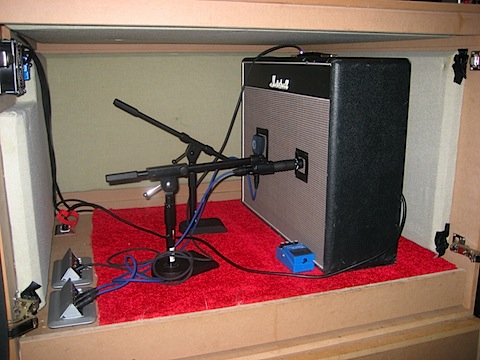

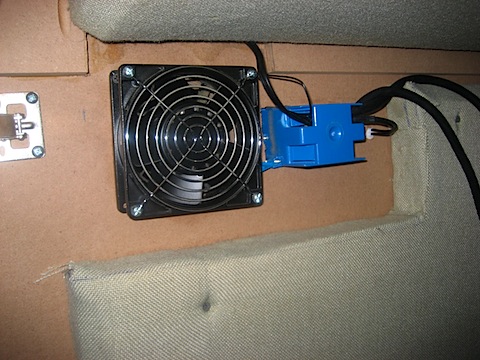
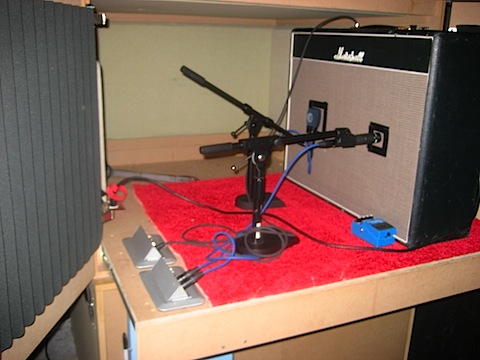

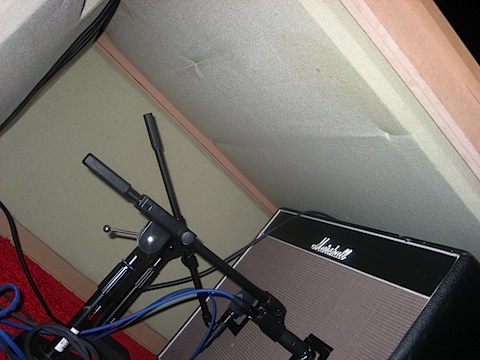
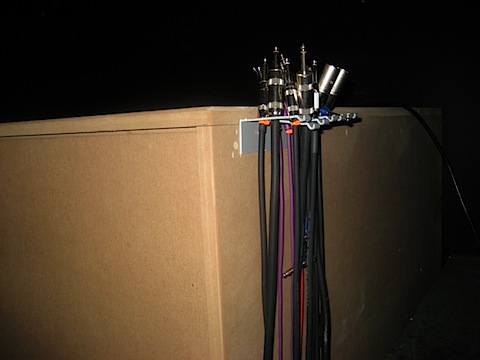
Hey Reid,
Did your guitar players give up on the X3 Lives?
A while back you talked about possible sharing some of your players X3 patches. Is that still a possibility?
Peace,
troy
No, they have not given up on the X3 Live. In fact, the vast majority of our regular guitarists still use the X3 Live. But there are still a handful of guys that rely on their amps, and we still get questions about the Iso Cabinets, hence my Round 3 post.
And I’ll get back to working on getting some patches…
Thanks, my friend!
Peace,
T
Great post!! I just have to copy it 🙂
I think I understand why you are making these enclosures for the amps,
(to keep the tone of the amp I presume)
But wouldn’t it be easier to use a nice Iso Speaker box instead, What is your experienve with ISo speakers or what have you heard positive or negative,
Would really like to know, I play in a church too. The X3live might suffice. But I am really into tone, and only have enough dough to do one trick or the other.
God Bless.
Martin,
Can you send a pic or link to the kind of Iso Speaker you’re talking about?
Is it something like this?
http://www.randallamplifiers.com/Cabinets/Isolation-Series-Cabs/Isolation.html
Reid,
Thanks for responding.
Yes!! It does look like your link. and also like this one.
http://www.riverainfo.com/index.php?view=article&catid=66%3Aisolation-cabinet&id=92%3Asilent-sister-isolation-cabinet-wpressure-relief&option=com_content&Itemid=54
I was wondering if you have ever tried these types of speaker “only”isolation boxes, It seems to me that they would be less hassle than having a whole amp inside a box than having to mess with the mic placement and volume knobs and such, from inside the box.. rather than outside the box,
then you only have the speaker and mics to deal with. I was curios why you don’t use this speaker only type instead? I am only assuming, but is it because you prefer the miced sound inside your version, as compared to the enclosed speaker version of isolating the amplified sound to run to
the main FOH, or perhaps it is bit more economical. I understand that each guitarist likes his own “speaker and amp combo”, but if you were able to just have the guitarist bring there amp for that service and run each amp through an isolation speaker box, to me it seems that it would be more
economical and less set up time. So my main question is… Have you ever used or thought about using the speaker only boxes for your church or no. If you have ever thought about it, what is your opinion on the difference and quality of each as far as sound quality and user friendliness, I heard
that the speaker boxes sound better than the full enclosure over the amp “but out of the mouth of 2 or 3 witnesses let every word be established”.
Thanks.
Martin
How quiet is the amp once in this iso box? Can it still be heard outside of the box? There is a church in my city that made them(not to your specs) and I was not impressed it was quieter but not enough to matter in my opinion. I am hoping there yours cut down the volume a lot or almost eliminate it.
Oh, you can still hear the amp when it’s inside the box. The sound is not eliminated – just contained.
BUT – it’s not an issue when the full band and PA are playing. I just wouldn’t noodle during the sermon 🙂
Could you send me the ISO Panel 2 PDF? It is no longer active on this site. Thanks!
That would be great to get as well. Thanks in advance!
I’d also like to see the ISO Panel 2 PDF. Could you send it to me? Thanks bro!
Please send me these PDF’s as well – if you get a chance!
Thanks!
I would really appreciate that as well. Could you please send it to me too? Thanks so much!
If you want it quieter, use thicker fiberglass/mineral wool (also, don’t use acoustic “foam”, it’s properties suck compared to fiberglass/mineral wool). Use say 4+” of 3-5 lb. (per cubic foot, i.e. PCF) and you’ll notice a LARGE drop in volume. I use spare 4″ panels from my studio when i run sound at churches (so not even configured in a box) and it does wonders for amps, as well as cymbals if positioned near them.
I have a question about iso boxes.
I am running an AC15 Combo but cant quite run it as hot as I’d like because of volume…is there a way to make a cover/iso box that will dissapate the heat, not compromise on tone and allow me to run a little hotter all without costing a fortune? Im only looking to gain a little and am not worried about having it soundproof, I’m just wanting to lower the overall volume a little.
Thanks for any help or suggestions!
Reid.. this post is very helpful, thank you! The 2nd & 3rd PDF’s in this post aren’t showing up, says file can’t be found.. If you still have access to these could you please send to me? Thanks! SC
+1.
Do you mind sharing them PDFs? 🙂
Blessing!
Does anyone have the files in the broken / file not found PDF links? I was hoping this would have been fixed, but I just checked again and they are still not working. Much appreciated!! I didn’t notice a way to contact Reid directly on this site to ask.
Sorry John – I’ll look for those files…
Hi Reid. This post is great, but the last two links are still broken. Anyway you can get those up or send them to me? Thanks! CR
Hello, we are looking into building two cabinets for our church and was wondering if you can send me the last two links that arent opening? Any other suggestions or realizations are welcomed as well! Thankyou – calin
This design is a bit unusual because of the cooling fan. I’m wondering:
1) If that is an exhaust fan, and if so, where does the cool air come in from?
2) Is it on all the time, or would having a thermostat be better?
3) Wouldn’t that cause sound isolation to be a lot worse?
Anyone know?
1 – Blows out (exhaust) so as to eliminate hot air. No input of “cool air”.
2 – on all time while amp is in use (rehearsals, performance). Whisper quiet, and continues exhaust of hot air.
3 – minimal sound difference. Fan hole is only about 4″-6″, and out of path of speaker. Benefits far outweigh an overheated & damaged amp.
Thanks. I guess one little fan is nothing compared to the 100s of dB from a typical amp.
Can’t see, though, how it would blow hot air well if there wasn’t cool coming in somewhere.
AirFlow needed. Otherwise, the fan is just lowering the pressure inside a little bit ?
(like a vacuum cleaner with the tube blocked)
our church just got a new board for pa system they want me to run my electic guitar straight thur the board instead of miking the amp is the right thing to do?
Aaakk!! Do you mean straight from your guitar, bypassing foot pedals or an amp simulator (POD, Kemper, etc.) so that FOH has control of your FX? Then NO WAY!!! But perhaps what they really mean is a desire for ampless connectivity, like a you using a POD or Kemper or other Direct-Out guitar amp simulator or FX unit. Those are common, and can eliminate the need for traditional amps. I know a few guys that actually prefer going direct out of a Kemper or POD because they are able to get a dialed-in, predictable tone regardless of the mics or venue, and the portability if fantastic – no lugging giant amps & cabinets. Now even they would agree that nothing beats a real amp and speaker moving real air, BUT… if you factor in transportation, micing, sound baffling, the quality of the monitoring system and PA speakers, and where your guitar actually lives in the final mix, then sometimes it just makes more sense to sacrifice a little bit on purity for the sake of whole.
Hope that helps!